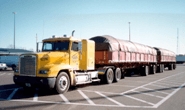Shipping and Logistics

Berg on the Headwinds and Tailwinds of Trucking
Written by Tim Triplett
March 10, 2020
Steel prices declined significantly in 2019—not good for steel producers and distributors or for the trucking companies that deliver their products, said Jim Berg, president of Jim Berg Trucking, in remarks last week at the Fabricators and Manufacturers Association Annual Meeting in San Antonio, Texas.
Trucking is a highly fragmented market, dominated by small companies with limited financial resources. Seventy-five percent of the North American truck capacity is operated by fleets of five or fewer vehicles. “These are small companies that have a hard time financing expansion,” he said. “The bankruptcy rate in 2019 was double that of 2018, and that will continue. The margins are too thin.”
Trucking companies continue to find it difficult to hire qualified workers, which constrains their ability to grow and meet market demand for shipments. “I am having a harder time finding mechanics than drivers, believe it or not,” Berg said.
Driving a truck is stressful work with long hours and does not fit the desired lifestyle of most young people entering the workforce, noted Berg, commenting on the persistent driver shortage. “With a low 3.5 percent unemployment rate, they have other options.”
The Federal Motor Carriers Safety Administration has stepped up efforts to monitor and prevent drug abuse by drivers in the interest of highway safety. Drivers now must register with the FMCSA’s Drug and Alcohol Clearinghouse. No longer can a driver who gets fired for a DUI simply get a job at another trucking company. Companies must now randomly test 50 percent of their workforce each year, up from 25 percent. Anyone who has a positive drug test must complete a mandated rehabilitation program to get rehired anywhere. “Last year, 9,000 drivers tested positive in the clearinghouse and cannot work unless they complete rehab. That’s a lot of lost trucking capacity,” Berg noted. “And 17 states have now made pot legal. What are we thinking?” he added.
On the positive side, Berg said, fuel costs are relatively stable, as are health care costs. Banks are lending money at favorable interest rates, so trucking companies have access to capital. And the regulatory climate is more business-friendly under the Trump administration. “The EPA requirements are more reasonable. I have replaced one-third of my tractors because I feel confident there will not be an increase in regulation,” he said.
On the political front, lack of infrastructure spending by the federal government continues to frustrate the trucking industry. “We lose $300 billion a year as a nation through congestion and crashes caused by the poor state of our infrastructure,” he noted. He supports a proposal by the American Trucking Association that calls for an increase in the federal fuel tax of 5 cents per gallon to fund critically needed road and bridge improvements.
The USMCA, which is replacing NAFTA, is positive news for cross-border carriers as it promises to speed the throughput of trucks and make shipments with Canada and Mexico more efficient and productive.
While it’s impossible to predict the recovery of the economy from the coronavirus, Berg said, “I think there is additional capacity at the current pricing. If the capacity is needed, you will see quick pricing increases and they could be dramatic.”

Tim Triplett
Read more from Tim TriplettLatest in Shipping and Logistics

US Great Lakes iron ore cargoes down notably through May
The Lake Carriers' Association reported a considerable decline in monthly iron ore shipments from US ports on the Great Lakes.

Wittbecker: West Coast port congestion
What's going on in West Coast ports?

Wittbecker: Mexico invests in port capacity despite US tariff troubles
The Mexican government aims to transform Manzanillo into the largest seaport in Latin America, capable of processing some 10 million TEU (20-foot equivalent units) per year by 2030. It is already Mexico's largest port and the third largest in Latin America, handling nearly 4 million 20-foot containers in 2024.

Wittbecker on Aluminum: When do the tariffs reach Main Street?
Containers sailing from China in April are down 15%-20% and Hapag Lloyd says their future bookings transpacific are down 30%.

Wittbecker on Aluminum: US-China trade war clobbers cross-Pacific trade
Container shipping lines have sharply increased blank sailings on Transpacific routes in response to escalating trade tensions between the US and China.
